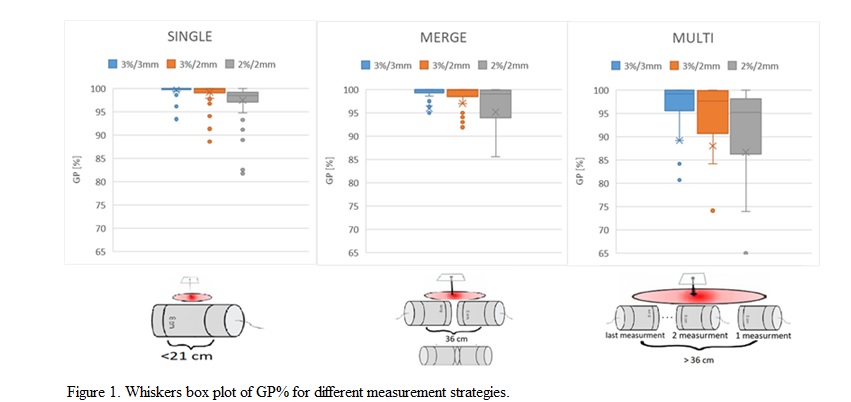Action and tolerance level dependance on single, merge and multi ArcCHECK measurement strategy.
Agnieszka Walewska,
Poland
PO-1722
Abstract
Action and tolerance level dependance on single, merge and multi ArcCHECK measurement strategy.
Authors: Agnieszka Walewska1, Aleksandra Juda1, Sandra Maluszczak1, Paulina Wesołowska1, Marta Fillmann1, Edyta Fujak1
1Maria Sklodowska-Curie National Research Institute of Oncology, Medical Physics Department, Warsaw, Poland
Show Affiliations
Hide Affiliations
Purpose or Objective
The aim of the study is to propose clinic specific tolerance limit (TLCS) and action limit (ALCS) obtained based on TG-218 [1] for patient specific quality assurance (PSQA) procedure for the first helical tomotherapy Radixact (Accuray) in our hospital. This work investigates whether the choice of the ArcCHECK measurement strategy influences TLCS/ALCS level.
Material and Methods
Between May and October 2022, 171 PSQA measurements delivered on Radixact unit were analyzed. The 3D diode array ArcCHECK (Sun Nuclear) was used to perform measurements. All PSQA was prepared in such a way that planning target volume was placed in the ArcCHECK centre. Since Radixact is a machine dedicated to long targets irradiation and the ArcCHECK matrix is 21 cm long, three measurement strategies (single, merge, multi) were applied depending on the of the target/high dose region (Fig. 1). Single strategy is dedicated to the smalest targets (<21 cm), merge measurement to longer (up to 36 cm) - two measurements with opposite ArcCHECK setups are required, while multi strategy to the longest ones (up to 135 cm). The multi strategy allows measurement along the entire length of the target and the protection of the electronics. In such case one measurement with ArcCHECK electronic facing gantry and a few (number depends on target ) measurements with standard device orientation with manual beam stop (to protect the electronics) are performed. For every measurement, the dose comparison was performed with 2D gamma global analysis using 5% dose threshold and 3%/3mm, 3%/2 mm, 2%/2mm criteria. Calculation according to TG-218 [1] has been used to define a clinic specific TLCS/ALCS for different measurement strategies using ArcCHECK.

Results
The calculated gamma passing rates (GP%) for the 171 cases were grouped by strategy (76 single, 51 merge, 44 multi) and the results are presented in Fig. 1. Obtained values clinical specific tolerance and action limits for particular criteria are presented in Tab.1. Values of TLCS/ALCS and average GP% decrease not only with the tightening of the gamma analysis criteria but also with the increase of the target length, which is related to the strategy.

Conclusion
The determined values of TLCS/ALCS limits allow optimal tolerance selection level for PSQA. Estimated clinic specific TLCS/ALCS are within TG-218 recommendation and will allow to tighten the applied GP% criteria to 97% (single and merge) and 93% for multi measurement strategy. For long irradiated fields lower GP%, TLCS/ALCS, should be expected. The dependence of GP%, TLCS/ALCS on ArcCHECK measurement strategies was demonstrated.
[1] Miften et al.: Tolerance limits and methodologies for IMRT measurement-based verification QA: Recommendations of AAPM Task Group No. 218, Med.Phys. 45(4) April 2018 http://dx.doi.org/10.1002/mp.12810